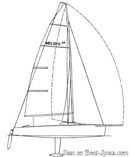Melges 24
Sailboat specifications
The Melges 24 is a 24’ (7.32m) one design sailboat designed by Reichel/Pugh Yacht Design (United States). She is built since 1993 by Melges (United States) and Devoti Sailing (Czech Republic).
Melges 24's main features
- Model
- Melges 24
- Hull type
- Monohull
- Category
- One design sailboat
- Sailboat builder
- Sailboat designer
- Sailboat collection
- Country
- United States
- Construction
- GRP (glass reinforced polyester):
Sandwich foam fiberglass polyester - Number of hulls built
- About 850
- First built hull
- 1993
- Last built hull
- Still in production
- Appendages
- Lifting keel : fin with bulb, lifting
- Helm
- Single tiller
- Rudder
- Single transom hung rudder
- Unsinkable
- No
- Trailerable
- Yes
- Standard public price ex. VAT (indicative only)
- About65 500 €(2020)
Melges 24's main dimensions
- Hull length
- 24’7.32 m
- Waterline length
- 22’6.71 m
- Beam (width)
- 8’ 2”2.5 m
- Draft
- 5’1.52 m
- Light displacement (MLC)
- 1784 lb809 kg
- Ballast weight
- 650 lb295 kg
- Ballast type
- Lead
Melges 24's rig and sails
- Upwind sail area
- 355 ft²33 m²
- Downwind sail area
- 828 ft²76.9 m²
- Mainsail area
- 226 ft²21 m²
- Jib area
- 129 ft²12 m²
- Asymmetric spinnaker area
- 602 ft²55.9 m²
- IiFore triangle height (from mast foot to fore stay top attachment)
- 27’ 11”8.49 m
- JiFore triangle base (from mast foot to bottom of forestay)
- 7’ 11”2.42 m
- PiMainsail hoist measurement (from tack to head)
- 28’ 11”8.81 m
- EiMainsail foot measurement (from tack to clew)
- 12’ 6”3.8 m
- Rigging type
- Sloop Marconi 7/8
- Mast configuration
- Deck stepped mast
- Rotating spars
- No
- Number of levels of spreaders
- 1
- Spreaders angle
- Swept-back
- Spars construction
- Carbon fiber mast and aluminum boom
- Standing rigging
- 1x19 strand wire continuous
Melges 24's performances
- Crew
- 4 – 5 (< 360kg)
- HN (French rating)iHN or "Handicap Nationale" is an empirical rating system used in France allowing various monohulls, of different sizes and designs, to race each other fairly. It is particularly suitable for cruiser and cruiser-racer. Therefore, by comparing these values, we can have an indication of the relative speed of 2 boats.
- 27.0
- Upwind sail area to displacementiThe ratio sail area to displacement is obtained by dividing the sail area by the boat's displaced volume to the power two-thirds.
The ratio sail area to displacement can be used to compare the relative sail plan of different sailboats no matter what their size.
Upwind: under 18 the ratio indicates a cruise oriented sailboat with limited performances especially in light wind, while over 25 it indicates a fast sailboat. - 409 ft²/T38.01 m²/T
- Downwind sail area to displacementiThe ratio sail area to displacement is obtained by dividing the sail area by the boat's displaced volume to the power two-thirds.
The ratio sail area to displacement can be used to compare the relative sail plan of different sailboats no matter what their size. - 953 ft²/T88.57 m²/T
- Displacement-length ratio (DLR)iThe Displacement Length Ratio (DLR) is a figure that points out the boat's weight compared to its waterline length. The DLR is obtained by dividing the boat's displacement in tons by the cube of one one-hundredth of the waterline length (in feet).
The DLR can be used to compare the relative mass of different sailboats no matter what their length:
a DLR less than 180 is indicative of a really light sailboat (race boat made for planning), while a DLR greater than 300 is indicative of a heavy cruising sailboat. - 76
- Ballast ratioiThe Ballast ratio is an indicator of stability; it is obtained by dividing the boat's displacement by the mass of the ballast. Since the stability depends also of the hull shapes and the position of the center of gravity, only the boats with similar ballast arrangements and hull shapes should be compared.
The higher the ballast ratio is, the greater is the stability. - 36 %
- Critical hull speediAs a ship moves in the water, it creates standing waves that oppose its movement. This effect increases dramatically the resistance when the boat reaches a speed-length ratio (speed-length ratio is the ratio between the speed in knots and the square root of the waterline length in feet) of about 1.2 (corresponding to a Froude Number of 0.35) . This very sharp rise in resistance, between speed-length ratio of 1.2 to 1.5, is insurmountable for heavy sailboats and so becomes an apparent barrier. This leads to the concept of "hull speed".
The hull speed is obtained by multiplying the square root of the waterline length (in feet) by 1.34. - 6.29 knots
Melges 24's auxiliary engine
- Engine(s)
- 1 outboard engine
Melges 24's accommodations and layout
- Cockpit
- Open aft cockpit
Similar sailboats that may interest you:
Sailboats
First built hull
Hull length
1992
24’ 6”7.48 m
1982
23’ 4”7.1 m
1977
25’ 1”7.65 m
1992
24’ 6”7.48 m
2017
32’9.75 m
2015
23’7 m
2009
19’ 11”6.07 m
2015
20’ 10”6.34 m
2011
19’5.79 m
2018
26’ 2”7.99 m
2005
31’ 10”9.7 m
1993
26’ 2”8 m
2012
22’ 8”6.93 m
2006
24’7.32 m
2012
26’ 2”7.99 m





